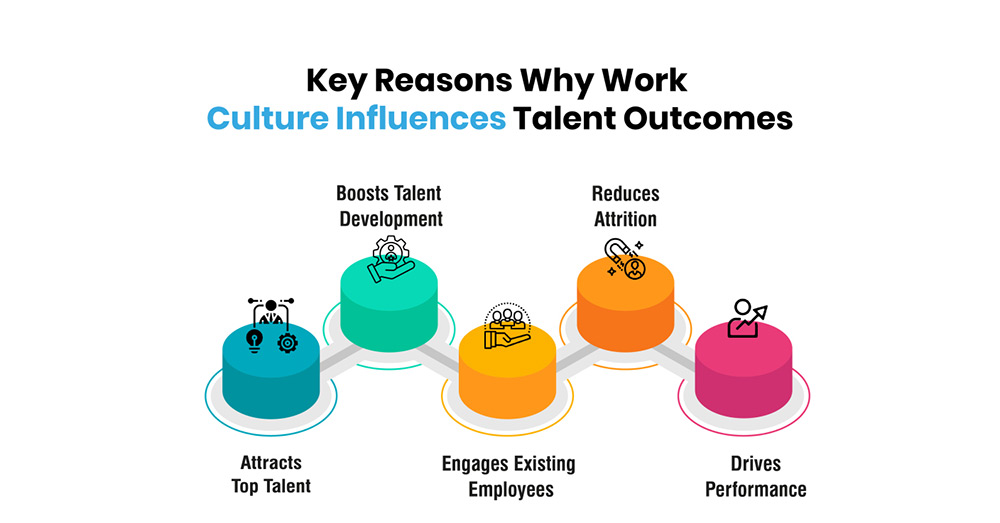
Attracting top talent and retaining key employees is crucial for organizational success. A positive work culture establishes an organization as an employer of choice and helps drive employee engagement and performance. This article discusses the impact of work culture on talent outcomes and outlines specific practices to cultivate a culture that attracts, hires, and retains top talent.
Work culture refers to the shared values, attitudes, standards, and beliefs that characterize how employees and management interact and perform their work. It includes elements like morale, trust between employees and leadership, work-life balance, opportunities for growth, and compensation and benefits. A healthy culture promotes collaboration, innovation, and high performance. It also impacts job satisfaction, motivation, and employees' overall experience of the organization.
Culture is shaped both by visible and invisible forces within an organization. Visible elements include the physical work environment, dress code, documentation processes, and operating structures. Invisible factors encompass underlying assumptions, prevailing attitudes, behavioral norms, and unwritten rules that guide how work gets done. Together, they define the way things are done around here.
Talented individuals today have high employment options and changing career preferences. They seek more than just salary and perks from prospective employers - a supportive culture where they feel valued, engaged, and able to contribute to their best abilities is equally important for attraction and retention. Here are some key reasons why work culture influences talent outcomes:

Top talent today makes career decisions not just on compensation but also organizational purpose, leadership quality, and work environment. A vibrant culture is thus essential to win the war for top talent.
Building a culture is an ongoing, systemic process requiring efforts across the business. Here are some tried-and-tested practices and recommendations to attract, hire and retain top talent through a purposeful, engaging culture:
When hiring new talent, look beyond just technical skills and experience. Prioritize culture adds - individuals whose values, personality and aptitudes enrich rather than dilute the existing culture. Define key attributes needed for cultural assimilation then design sourcing, assessments and interviews to identify the best fit.
Use behavioral questions to understand a candidate's past behaviors and decisions in diverse work situations. Check cultural fit through situational and values-based questions testing respondents' priorities, leadership style, contributions preferences and reasons for interest in the role and organization.
Seek referrals from existing top performers who best understand Cultural demands and can identify talent displaying similar Attributes. Reference and background checks also verify applicants' cultural adaptability. Onboard new hires to instill Cultural ownership while socializing them into existing norms.
Certain companies have built strong reputations as great places to work due to their attention to building a positive organizational culture. Two prime examples are AT&T and Google. Each company understands the link between culture and business success. They recognize that empowering and caring for their employees is key to achieving their strategic goals.
AT&T underwent a transformation to better serve customers in a disrupted industry. Vice President Melissa Corwin and her team knew internal change was needed. They conducted focus groups and surveys to analyze employee feedback and identify strengths and areas for growth. 16 behaviors emerged relating to customer centricity, empathy, and empowerment. These were distilled into four cultural pillars:
AT&T then aligned HR practices like performance reviews, goals, and recognition around demonstrating these behaviors. Leaders were held accountable for cultivating the culture. Initiatives like "Project Raindrops" automated processes to return 3.6 million hours to frontline employees for serving customers.
The results have been impactful. Employee NPS scores, a measure of customer experience quality, increased. AT&T ranks highly on diversity lists due to its inclusion programs. A focus on transparency also enhances the culture. With cultural transformation integrated into its business strategy, AT&T has strengthened its position in a disrupted industry through engaged, empowered talent.
Google similarly makes culture a priority to attract skilled workers. It embraces ideas of empathy, expertise, and open communication. Perks contribute to work being an enjoyable experience. Employees have flexible schedules, free gourmet meals, and on-site services like dry cleaning or a doctor's office. Workspaces feel more like fun campuses with games and recreation areas.
Core to Google's culture, however, is empowering employees' potential for innovation. 20% of working time can be spent on independent projects. This encourages new ideas and aids employee development and satisfaction. Workers are given leadership responsibility early in their careers too. Platforms like Googlegeist allow anonymous feedback. Overall, the culture combines enjoyment with intellectual challenge and growth.
The results for Google include worldwide recognition as a top company to work for. This helps attract a sought-after talent pool. Employee surveys consistently show high marks for leadership, prestige, and work/life balance. Turnover remains low as people want to stay. This attraction and retention of skilled labor translate directly to business success as new products and services emerge from Google's innovative environment.
Ultimately companies like AT&T and Google prove that strategic focus on building positive work cultures delivers benefits. It engages existing talent, attracts new top performers, and directly aids the bottom line.
With competition for skills fierce, these organizations use culture as a competitive differentiator that drives business results. Their examples demonstrate the importance of empowering employees, removing obstacles, and aligning HR practices around a clearly defined purpose and values. This holistic culture-driven approach retains current workers and draws new ones, fueling ongoing success.
Nurturing a vibrant, purposeful work culture is essential to attracting top talent in today's competitive landscape. Positive culture enhances employee engagement and drives innovation and high performance while also improving retention of top performers. By understanding talent needs and cultivating the outlined practices systematically, organizations can create an environment where the best individuals thrive and contribute their capabilities fully for mutual growth. This earns an employer a strong talent brand while equipping them to outperform industry peers.

CredBadge™ is a proprietary, secure, digital badging platform that provides for seamless authentication and verification of credentials across digital media worldwide.
CredBadge™ powered credentials ensure that professionals can showcase and verify their qualifications and credentials across all digital platforms, and at any time, across the planet.

Please enter the License Number/Unique Credential Code of the certificant. Results will be displayed if the person holds an active credential from TMI.